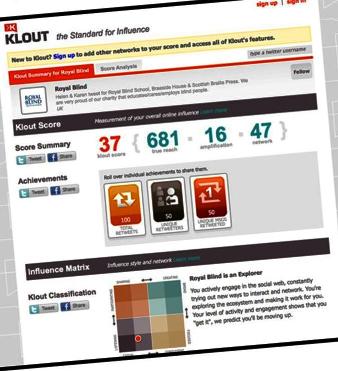You’ve created a Facebook Page, styled your Twitter profile and littered comments across your LinkedIn groups. But how do you know if it’s working?
Unlike paid advertising, where you can use hard and fast figures to measure your ROI, monitoring your SMM campaigns can be a little trickier. There are a range of KPIs that you can use; numbers of fans, number of followers – but these figures alone don’t reveal how successfully you’ve managed to engage with these people.
The most important thing to remember – beyond recognising that every company will have different KPIs and there isn’t one ‘right’ goal – is that you don’t have to be on every single social media platform available on the web. What works for Red Bull – Facebook advertising and a YouTube channel – won’t necessarily work for your local accountant.
![]() If your social media presence is a year old or more, you’ll have seen traction with some platforms and a lack of traction with others – ditch the communities that aren’t growing and put your energies into those that are. If your pages or profiles aren’t growing as well as you’d hoped, check your demographic research to make sure you’re engaging on the right platform. Like you target your website in its appearance and copy, so you need to target your social media activities. If its B2B you’re interested in, LinkedIn or Twitter are going to be more productive than Facebook. If it’s the silver surfer generation you want to capture, online forums like Saga Zone are a good place to start.
If your social media presence is a year old or more, you’ll have seen traction with some platforms and a lack of traction with others – ditch the communities that aren’t growing and put your energies into those that are. If your pages or profiles aren’t growing as well as you’d hoped, check your demographic research to make sure you’re engaging on the right platform. Like you target your website in its appearance and copy, so you need to target your social media activities. If its B2B you’re interested in, LinkedIn or Twitter are going to be more productive than Facebook. If it’s the silver surfer generation you want to capture, online forums like Saga Zone are a good place to start.
Presuming you’ve nailed these preliminaries, there are basic metrics you can use to monitor your SMM success. We said earlier that figures alone aren’t a good metric, but the number of fans or followers you have on Facebook or Twitter is an immediate way to establish where you’re at. It’s more useful however, to know where those people come from. Are they already clients of yours? Are they industry related figures? Or are they a seemingly random connection – in which case is there a potential for business? For instance, if you discover that your Twitter profile is only being followed by existing clients, then you may want to treat it more as a customer helpline.
You can measure engagement by monitoring the interaction on your profiles. How often do your Tweets get re-tweeted and who is it that’s re-tweeting them? Are fans liking your Facebook posts and writing comments in response? Once you establish the type of engagement you receive, you can adapt your content accordingly. What sort of content generates the most reaction on your profiles? We’ve found that when we blog that a new site has gone live, we get a lot of interest from companies in the same sector as our client; which provides a great opportunity to generate new leads.
 If you’re stuck for content, have a look at the competition – what are they doing with their social media that seems to attract fans and followers?
If you’re stuck for content, have a look at the competition – what are they doing with their social media that seems to attract fans and followers?
Finally, take a second look at the posts, tweets, links and videos that social media users have engaged with. How long did it take them to respond to your activity? More importantly, did you communicate back to them i.e. by thanking them for a re-tweet or answering their questioning post? Responding to your fans and followers is crucial to maintaining a relationship – if they don’t think you’re giving them enough attention, it’s easy to go elsewhere.
Those are the key metrics that we advise our clients to use. Have we forgotten any? If you think we’ve missed a key factor of our list, tell us below!


